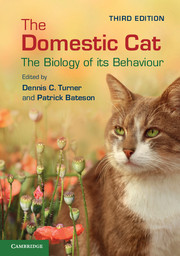Book contents
- Frontmatter
- Contents
- Contributors
- Abbreviations
- I Introduction
- II From Kitten- to Adulthood
- III Social Life and Ecology
- IV Cats and People
- 7 Domestication and history of the cat
- 8 Cultural differences in human–cat relations
- 9 Human and cat personalities: building the bond from both sides
- V Cat Breeding and Cat Welfare
- VI The Future
- References
- Index
7 - Domestication and history of the cat
Published online by Cambridge University Press: 05 December 2013
- Frontmatter
- Contents
- Contributors
- Abbreviations
- I Introduction
- II From Kitten- to Adulthood
- III Social Life and Ecology
- IV Cats and People
- 7 Domestication and history of the cat
- 8 Cultural differences in human–cat relations
- 9 Human and cat personalities: building the bond from both sides
- V Cat Breeding and Cat Welfare
- VI The Future
- References
- Index
Summary
Origins of the cat
Although the ancestors of the domestic cat (Felis silvestris catus) first appeared about 35 million years ago (MYA) during the late Eocene, the cat family or Felidae, to which all living cat species belong, emerged somewhat later during the Miocene about 10–11 MYA (Johnson & O’Brien, 1997; O’Brien et al., 2008). Morphological and molecular studies of phylogenetic relationships among living felids indicate that the 37 extant species can be divided up into 8 major phylogenetic groups or lineages: the Panthera lineage; the bay cat lineage; the leopard cat lineage; the caracal lineage; the ocelot, lynx and puma lineages; and, finally, the domestic cat or Felis lineage (Leyhausen, 1979; Collier & O’Brien, 1985; Salles, 1992; Johnson & O’Brien, 1997; O’Brien et al., 2008). The latter is believed to have diverged from the others around 6.2 MYA, and comprises four species of small cats that seem to have originated around the Mediterranean basin: the jungle cat (Felis chaus), the black-footed cat (F. nigripes), the sand cat (F. margarita) and the wildcat (F. silvestris) (O’Brien et al., 2008).
- Type
- Chapter
- Information
- The Domestic CatThe Biology of its Behaviour, pp. 83 - 100Publisher: Cambridge University PressPrint publication year: 2013
- 5
- Cited by



